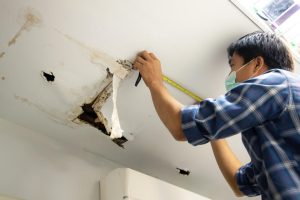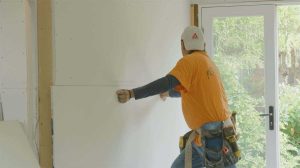Drywall is one of the most common building materials used in homes today. It is a type of wallboard made from gypsum plaster and paper, and it is used to create smooth, flat walls and ceilings. While drywall is durable and long-lasting, it can still become damaged over time due to accidents or wear and tear. When this happens, homeowners may need to hire a professional to repair their drywall. The cost of drywall repair varies depending on several factors, including the extent of the damage, the size of the affected area, and the location of the home. In this article, we’ll take a closer look at how much you can expect to pay for drywall repair services so that you can prepare your budget accordingly.
Why drywall repair is important

Drywall is an essential component of any building or home. It not only provides a neat and smooth finish to the walls but also contributes to the insulation and fire safety of the house. However, drywalls are prone to damage due to various reasons such as moisture, accidental impacts, or regular wear and tear. Ignoring even minor damages can lead to larger problems like mold growth, weakening of structural integrity, or even electrical hazards.
Therefore, timely drywall repair is crucial for maintaining the safety and aesthetics of your house. The cost of repairing drywall depends on the severity and location of damage. Typically, small holes or cracks can be easily repaired using DIY techniques that involve filling up with spackle or joint compound. However, for more significant damages like large holes or water damage repairs may require professional assistance that may cost anywhere between $50-$500 depending on the extent of damage and labor involved in repairing it.
Factors affecting cost:
Factors affecting the cost of drywall repair include the extent of the damage, the type of repair required, and the cost of materials. Large holes or cracks will require more time and materials to repair, which will increase the overall cost. Additionally, if additional work is required such as removing old drywall or replacing insulation, this can also increase costs.
Another factor affecting drywall repair costs is location. Contractors in different areas may have varying rates for their services due to differences in labor costs and local market conditions. Furthermore, if a homeowner requires urgent repairs outside of normal business hours or on weekends, they may incur additional charges for emergency services. Overall, homeowners should consider these factors when budgeting for drywall repairs and seek out multiple quotes from reputable contractors in their area to ensure that they receive a fair price for quality workmanship.
Size, location, skill level required

When it comes to drywall repair costs, there are several factors that come into play. One of the most significant factors is the size of the repair needed. Larger repairs will obviously cost more than smaller ones, as they require more time, materials, and labor to complete.
Another factor that can affect the cost of drywall repair is its location within your home. If the damaged area is in a hard-to-reach spot or requires specialized equipment to access, you may incur additional costs for labor or equipment rental fees. The skill level required for the job also plays a role in determining its overall cost. While minor repairs may be relatively easy for a DIYer with some basic skills and tools, larger or more complex repairs often require professional expertise and specialized tools. As such, you should expect to pay more for an experienced contractor who can provide high-quality workmanship and reliable service.
Common types of repairs:
The most common types of repairs for drywall include fixing holes, cracks, and water damage. Hole repairs can range from small nail holes to larger holes caused by furniture or accidents. For small nail holes, a simple patching compound can be used while larger holes may require cutting out damaged sections and installing new drywall.
Crack repairs are also a frequent issue with drywall. These can occur from settling in the home, shifting foundations, or simply age. Small cracks can be easily filled with spackle or joint compound while larger cracks may require taping before applying the joint compound.
Water damage is another type of repair commonly faced with drywall. This occurs when moisture seeps into the wall causing it to soften and crumble. Depending on the extent of the damage, this may require replacing entire sections of drywall or just a simple patching job.
Holes, cracks, water damage

Holes, cracks, and water damage are common problems that homeowners encounter with their walls. These issues can be caused by a variety of factors such as age, moisture, pests, or accidental damages. Holes and cracks can be small or large depending on the severity of the damage. Water damage can also range from minor stains to major rotting and mold growth.
When it comes to repairing drywall holes and cracks, the cost can vary depending on the size of the damage and the location of the repair. Small holes or cracks may only require simple patching techniques using spackling paste or joint compound which may cost around $50-$100 per repair job.
Water damage repairs tend to be more expensive due to the extent of damage caused by moisture buildup in wall cavities. Repair costs generally start at $150 for minor water stains but could increase significantly for major repairs involving mold remediation or structural damage restoration.
DIY vs hiring a professional:
When it comes to repairing drywall, homeowners are often faced with the decision of whether to tackle the job themselves or hire a professional. The cost of a drywall repair can vary greatly depending on factors such as the extent of damage and location in the home. On average, homeowners can expect to pay anywhere from $150 to $1,000 for a typical drywall repair.
DIY enthusiasts may be tempted to tackle drywall repairs on their own in order to save money. While this can certainly be a cost-effective option, it is important for homeowners to consider their level of skill and experience before attempting any major repairs. Drywall repair requires precision and attention to detail, making it more difficult than many people realize. Hiring a professional for drywall repair may come at a higher cost initially, but it could ultimately save money in the long run by ensuring that the job is done correctly and preventing further damage down the line. Professional contractors have access to specialized tools and materials that may not be available for DIY projects, allowing them to complete repairs quickly and efficiently while also maintaining high quality standards.
Pros and cons of each option
Option 1: DIY Drywall Repair
Pros:
- Cost-effective as you can save money on labor costs.
- You have control over the repair process and timeline.
- You can learn a new skill and gain experience in home repairs.
Cons:
- Risk of making mistakes if you are not experienced in drywall repair, leading to additional costs.
- It may take longer to complete the repair as compared to hiring a professional.
- DIY repairs may not be up to code or meet aesthetic standards, affecting the value of your home.
Option 2: Hiring a Professional Drywall Contractor

Pros:
- Quality workmanship as professionals have specialized skills and equipment for drywall repair.
- Saves time as they can complete repairs quickly, minimizing disruptions in your daily routine.
- Professionals ensure that the repairs meet building codes, safety standards, and aesthetic expectations.
Cons:
- Higher cost due to labor fees and materials expenses.
- Limited flexibility as you need to align with their schedule for availability
- There is always a risk of choosing an unqualified or dishonest contractor who could do substandard work.
Average costs:
The average cost of drywall repair varies depending on the extent of damage and the size of the affected area. For minor repairs, such as small holes or cracks, homeowners can expect to pay around $50 to $100. However, larger damages like water damage or significant holes can result in higher costs ranging from $150 to $1,000.
Other factors that may influence repair costs include labor fees and materials required for the job. Labor rates typically range from $50 to $75 per hour. Materials required for a typical drywall repair job include spackle or joint compound, sandpaper, and paint. On average, these materials can cost between $10 to $30 depending on the brand used. Overall, homeowners can expect drywall repair costs to range between $50 and upwards of over a thousand dollars depending on factors such as damage severity and material requirements. It is always recommended that homeowners consult with a professional contractor who can provide estimates specific to their needs before committing to any repairs.
National and regional averages
National and regional averages play a crucial role in determining the cost of drywall repair. The national average for repairing drywall is $330, with prices ranging from $150 to $500. However, the cost can vary significantly depending on location and other factors such as the severity of damage, type of repair required, and complexity of the project.
In some regions like rural areas or small towns, where there are fewer contractors available for hire, costs may be higher due to increased demand. On the other hand, larger cities with more competition may have lower prices due to an abundance of contractors vying for customers.
Conclusion:
In conclusion, the cost of a drywall repair can vary greatly depending on several factors. The first factor to consider is the size and scope of the repair needed. A small hole or crack may only cost a few hundred dollars to repair, while a larger area that requires extensive work could cost thousands of dollars. Another factor that affects the cost of drywall repair is the location of the damage. If it’s in an easily accessible area, such as a living room wall, then it may be less expensive than if it’s in a hard-to-reach area like a ceiling or high up on a wall. The type and quality of materials used for the repair can also impact the final price.